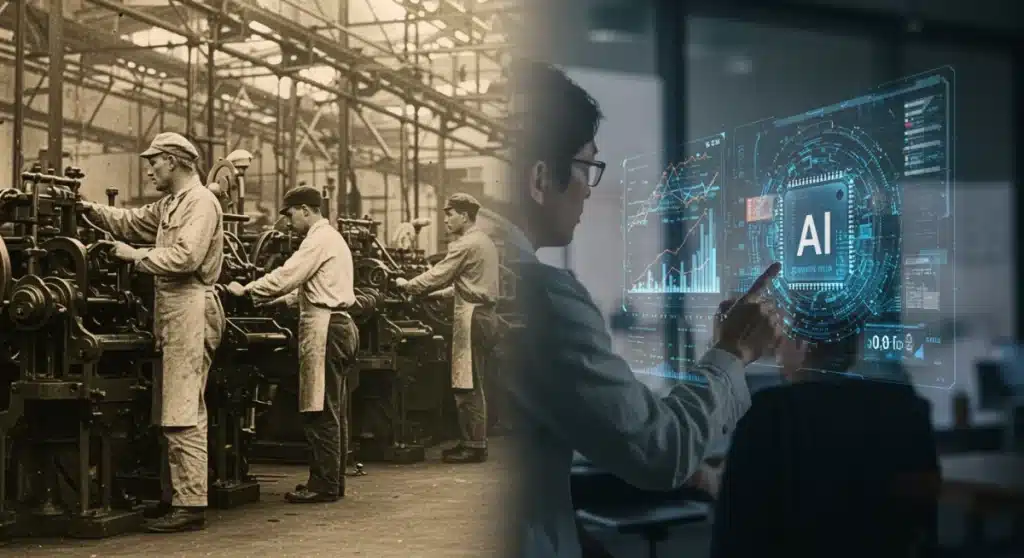AI’s Impact on US Employment: Historical Context & 2025 Outlook

The Historical Impact of Technological Revolutions on US Employment: Preparing for AI in 2025 (FINANCIAL IMPACT) reveals how past innovations reshaped labor markets, providing crucial lessons for anticipating artificial intelligence’s economic consequences by 2025.
The landscape of American employment has always been in flux, shaped by waves of innovation. Today, as Artificial Intelligence (AI) rapidly integrates into every sector, the question isn’t if jobs will change, but how profoundly. Understanding The Historical Impact of Technological Revolutions on US Employment: Preparing for AI in 2025 (FINANCIAL IMPACT) is paramount for workers, businesses, and policymakers alike. What can history teach us about navigating this new frontier?
Echoes of the Industrial Revolution in Today’s AI Shift
The First Industrial Revolution, marked by steam power and mechanization, drastically altered the agricultural and artisanal economies of the 18th and 19th centuries. Millions of individuals transitioned from farms to factories, often facing initial displacement, harsh working conditions, but ultimately leading to new industries and widespread economic growth. The parallels between this historical upheaval and the current AI-driven transformation are becoming increasingly clear, prompting a re-evaluation of how societies adapt to profound technological change.
Initially, mechanization led to significant job losses in traditional crafts. Weavers, spinners, and artisans found their skills rendered obsolete by machines that could produce goods faster and cheaper. This period, however, also saw the birth of entirely new roles, from factory managers and engineers to machine operators and maintenance workers. The economic structure shifted from localized, craft-based production to mass manufacturing, creating a new class of industrial workers and fundamentally redefining the nature of labor. The financial impact was immense, fostering unprecedented wealth accumulation alongside significant social challenges.
Job Displacement and Creation Cycles
Historically, new technologies have always caused a reshuffling of the labor market, not just outright destruction. While specific jobs vanish, new ones emerge, often requiring different skill sets.
- Agricultural Shift: From manual labor to machine operation, freeing up labor for urban factories.
- Manufacturing Boom: Creation of diverse factory roles, from assembly line workers to supervisors.
- Service Sector Growth: As wealth increased, demand for services expanded, generating new employment opportunities.
The financial implications of these shifts were complex. While some workers saw their livelihoods disappear, others found higher wages and improved living standards in the new industrial economy. This cyclical pattern of displacement and creation is a critical lens through which to view the ongoing AI revolution.
The Digital Age: Lessons from the Internet and Automation
The advent of the internet and widespread computer automation in the late 20th and early 21st centuries provides a more recent historical context for understanding AI’s potential impact. These technologies revolutionized information processing, communication, and business operations, leading to significant changes in various industries. While they streamlined many tasks and improved efficiency, they also led to the automation of routine jobs, particularly in administrative and manufacturing sectors.
Consider the banking industry. Before digital platforms, tellers handled nearly all transactions. With ATMs, online banking, and mobile apps, many of those routine tasks became automated. This didn’t eliminate bank jobs entirely, but it shifted the focus for remaining employees towards more complex customer service, financial advisory roles, and technical support for digital systems. The financial sector adapted by requiring new skills, emphasizing digital literacy and analytical capabilities over purely transactional functions.
Evolving Skill Requirements
The digital revolution underscored the importance of adaptability and continuous learning. Workers who embraced new tools and acquired digital skills were better positioned to thrive.
- IT Professionals: A massive surge in demand for programmers, network administrators, and cybersecurity experts.
- Data Analysts: New roles emerged to interpret the vast amounts of data generated by digital platforms.
- Customer Support Evolution: From purely in-person to multi-channel digital support, requiring different communication skills.
The financial impact was evident in the widening wage gap between those with in-demand digital skills and those without. Companies that successfully integrated digital technologies often saw increased productivity and profitability, while those that lagged behind faced competitive disadvantages. This period highlighted that technological advancement often disproportionately benefits those prepared to leverage it.
AI in 2025: Anticipating the Immediate Financial Impact
As we approach 2025, the proliferation of AI is set to accelerate, bringing with it both opportunities and challenges for the US employment landscape. Unlike previous revolutions that primarily automated physical or routine cognitive tasks, advanced AI is now capable of performing more complex cognitive functions, including analysis, prediction, and even creative tasks. This means a broader range of jobs, from administrative roles to creative industries, could see significant transformation.
The immediate financial impact will likely manifest in several ways. Companies adopting AI are expected to see efficiency gains and cost reductions, which can translate into higher profits, but also potentially fewer jobs requiring human intervention for certain tasks. Conversely, new industries and job categories directly related to AI development, deployment, and maintenance are already experiencing rapid growth. This includes AI researchers, machine learning engineers, data scientists, and AI ethics specialists, all commanding high salaries due to specialized skill sets.
Sector-Specific Vulnerabilities and Growth
Certain sectors are more susceptible to AI-driven automation, while others are poised for growth due to AI integration.
- Manufacturing & Logistics: Increased automation through AI-powered robotics and optimized supply chains.
- Customer Service: AI chatbots and virtual assistants handling routine inquiries, freeing human agents for complex issues.
- Healthcare: AI assisting in diagnostics, drug discovery, and personalized treatment plans, creating new support roles.
The financial implications for individuals will vary greatly. Workers in highly automatable roles may face downward wage pressure or job displacement, necessitating reskilling. Those in roles augmented by AI, or in newly created AI-centric positions, are likely to see increased demand and potentially higher earnings. The challenge lies in ensuring a smooth transition for the workforce to minimize widespread economic disruption.
Reskilling and Upskilling: The Imperative for the Modern Workforce

The historical record unequivocally shows that adapting to new technologies requires a workforce capable of acquiring new skills. For The Historical Impact of Technological Revolutions on US Employment: Preparing for AI in 2025 (FINANCIAL IMPACT) to be positive, massive investment in reskilling and upskilling programs is not just beneficial, but essential. Governments, educational institutions, and private companies must collaborate to provide accessible and relevant training that prepares workers for the jobs of tomorrow.
This isn’t merely about learning to use new software; it’s about fostering critical thinking, creativity, problem-solving, and emotional intelligence—skills that AI is currently less capable of replicating. For example, while AI can analyze vast datasets, humans are still needed to interpret nuances, make ethical judgments, and innovate. Training programs should focus on these uniquely human attributes, alongside technical proficiency in AI tools and platforms. The financial return on investment for such programs can be substantial, both for individuals in terms of career longevity and for the economy through a more productive workforce.
Key Areas for Skill Development
To thrive in an AI-driven economy, certain skill sets will become increasingly valuable and in-demand.
- Digital Literacy & AI Proficiency: Understanding how AI works and how to effectively use AI tools.
- Critical Thinking & Problem Solving: Analyzing complex situations and devising innovative solutions.
- Creativity & Innovation: Developing new ideas, products, and services that AI can then help scale.
- Emotional Intelligence & Collaboration: Working effectively with diverse teams and managing human interactions.
The financial implications for businesses neglecting reskilling can be severe, leading to talent shortages, reduced productivity, and an inability to leverage AI effectively. Conversely, companies investing in their human capital will likely gain a competitive edge, fostering employee loyalty and a more adaptable workforce capable of navigating future technological shifts.
Policy Responses and Economic Adjustments for AI Integration
Effective policy responses are crucial to mitigate the negative financial impacts of AI on employment and to maximize its benefits. Governments must move beyond reactive measures and proactively design frameworks that support workers, stimulate innovation, and ensure equitable distribution of AI’s economic gains. This includes revisiting education systems, exploring new social safety nets, and incentivizing businesses to invest in their workforce rather than solely replacing human labor.
One area of focus is the potential for universal basic income (UBI) or similar social safety nets to provide a financial cushion for those displaced by automation, allowing them time to retrain. Another is the reform of unemployment benefits to include robust training components. Furthermore, tax incentives for companies that invest in upskilling their employees or create new AI-augmented jobs can encourage responsible AI adoption. International cooperation on AI policy is also becoming increasingly important to address global labor market implications and ensure fair competition.
Governmental and Corporate Strategies
A multi-faceted approach involving various stakeholders is necessary to navigate the AI transition successfully.
- Educational Reform: Aligning curricula with future job market demands, emphasizing STEM and soft skills.
- Worker Re-training Programs: Government-subsidized or employer-led initiatives for skill acquisition.
- Ethical AI Development: Regulations ensuring AI is developed and deployed responsibly, considering societal impact.
- Investment in AI Infrastructure: Funding research and development to maintain a competitive edge and create new industries.
The financial stability of individuals and the broader economy hinges on these proactive policy adjustments. Without them, the risk of increased income inequality and social unrest grows. With thoughtful planning, AI can be a powerful engine for economic growth and societal improvement, rather than a source of widespread dislocation.
Long-Term Financial Outlook: AI’s Potential for Economic Growth
While the immediate challenges of AI integration into the US employment market are significant, the long-term financial outlook suggests substantial potential for economic growth and improved living standards. Historically, every major technological revolution, after an initial period of disruption, has ultimately led to greater productivity, new industries, and an overall increase in wealth. AI is poised to follow this pattern, potentially unlocking unprecedented levels of efficiency and innovation across all sectors.
AI’s ability to automate routine tasks can free up human capital for more complex, creative, and strategically valuable work. This augmentation of human capabilities can lead to higher overall productivity, which is the bedrock of economic growth. Furthermore, AI is driving the creation of entirely new products, services, and business models, from personalized medicine to autonomous transportation and advanced climate modeling. These innovations will not only generate new revenue streams but also create new categories of jobs that don’t even exist today, offering significant financial opportunities.
Benefits of AI-Driven Productivity
The enhanced productivity brought about by AI has far-reaching positive financial implications for businesses and the economy.
- Increased Efficiency: AI optimizes processes, reducing waste and operational costs for businesses.
- Innovation Acceleration: AI tools speed up research and development, leading to faster product cycles.
- New Market Creation: AI enables the development of previously unimaginable goods and services.
- Higher Wages & Living Standards: Increased productivity can lead to higher wages and a better quality of life for workers.
The financial benefits are not limited to corporate profits; they can also translate into higher wages, more leisure time, and improved public services, provided that the gains are broadly distributed. The long-term vision for an AI-integrated economy is one where human ingenuity is amplified, leading to a more prosperous and innovative society. However, achieving this positive future requires careful management of the transition, informed by the historical lessons of past technological shifts.
| Key Impact Area | Brief Description |
|---|---|
| Historical Displacement | Past revolutions, like industrialization, caused job shifts but ultimately created new sectors and roles. |
| AI Job Transformation | AI will automate routine tasks, creating demand for AI-specific roles and augmented human-AI collaboration. |
| Reskilling Imperative | Continuous learning and developing human-centric skills are crucial for workforce adaptability and financial stability. |
| Economic Growth Potential | Long-term, AI can boost productivity, foster new industries, and elevate living standards if managed strategically. |
Frequently Asked Questions About AI’s Impact on Employment
By 2025, AI is expected to automate many routine cognitive tasks, leading to job displacement in some sectors but also creating new roles in AI development, maintenance, and human-AI collaboration. The financial impact will vary by industry and individual skill sets, emphasizing adaptability.
Past revolutions, like the Industrial and Digital Ages, show initial job displacement followed by the creation of new industries and roles. They highlight the critical need for continuous reskilling and upskilling to align the workforce with evolving technological demands and maintain economic stability.
Skills such as critical thinking, creativity, complex problem-solving, emotional intelligence, and digital literacy (especially AI proficiency) will become increasingly valuable. These human-centric attributes are difficult for AI to replicate and will be essential for roles augmented by artificial intelligence.
Preparation involves investing in comprehensive reskilling programs, educational reform, and exploring new social safety nets like UBI. Businesses should incentivize employee training and focus on creating AI-augmented roles rather than solely replacing human labor to foster sustainable growth.
While short-term disruption is expected, the long-term outlook suggests AI will drive significant economic growth through increased productivity, innovation, and the creation of entirely new industries and job categories. Strategic management of the transition is key to realizing these benefits.
What Happens Next
As AI continues its rapid integration across US industries, the focus shifts to proactive adaptation rather than reactive recovery. The coming months will be critical for businesses to assess their AI adoption strategies, for educational institutions to refine curricula, and for policymakers to implement supportive legislation. Expect to see increased discussions around AI ethics, data privacy, and the future of work, all of which will shape the financial landscape of employment. The ongoing dialogue and collaborative efforts between technology developers, labor organizations, and government entities will largely determine the extent of AI’s positive financial impact on the US workforce.





